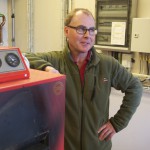Farm description
Trägsta is located 70 kilometers outside of Östersund in the middle of Sweden. Here the farmers Eva and Torgny Widholm produce milk from 140 dairy cows and the farm has been managed organically since 2008.
The farm consists of 260 hectares of arable land and 20 ha grazing land. The main crop rotation is four years of ley followed by wheat and field beans or barley and peas harvested as green fodder. The last year they cultivate barley under-sown with ley.
The proportion of roughage in the dairy cow’s diet has gradually increased and is currently at 70-80%. The cows, however, remain producing on a good level of around 9000 kg milk per year.
The farm has a biogas plant where all the manure is digested. Eventually, even bedding could be digested. The gas is used to power a electric turbine which produces electricity and spare heat is used as a heating source for residential buildings and barns.
Climate friendly practices applied
- Improved on-farm nutrient management
Anaerobic treatment (biogas) of liquid and solid manure
Manure is subjected to anaerobic fermentation to generate and capture CH4. This is burned in an engine to generate electricity and heat energy so that the use of fossil fuels is replaced. Liquid and solid residues are brought back to agricultural land and because of a higher percentage of mineral nitrogen, yield increase is likely.
- Optimised crop rotations with legumes
Extending usage of forage legume leys by 1 year
Farm extends the utilisation period of forage legume leys from 4 to 5 years by introducing innovative re-seeding techniques to avoid leys destruction. Forage legumes contribute to nitrogen fixation (reduction of N2O emission) and carbon sequestration. Resown legumes improve nitrogen fixation and fodder protein quality.
- Optimised tillage systems
Reduced tillage through extending usage of forage legume leys
Farm extends the utilisation period of forage legume leys from 4 to 5 years and spares soil tillage for 1 year barley instead. By employing these practices diesel consumption will be reduced along with humus accumulation in soil (carbon sequestration)
- Agroforestry
Silvopastoral system
The farm has a fenced mixed forest/grazing area on 15-20 hectares. The last years it has been grazed by some 100 sheep from a neighbouring farm. The farmers start grazing this area with their young cattle. They would also like to keep their partnership going with the sheep farmer. The goal of the agroforestry activities is to develop this area with the mixed objectives of enhancing grass production in areas which are now being forested while focusing on the highest economic value on the trees which are left in the field. Pines are to be stem pruned for maximizing timber value while allowing more light to reach the ground. Some spruce are kept (sold as wood pulp). Birches as managed for firewood. Grey alders are kept as nitrogen fixers. Some junipers are saved for wildlife.
These practices lead to carbon sequestration in above- and belowground biomass and in soil. Part of the woody biomass is used for heating and thus replaces fossil fuel (CO2 mitigation).
